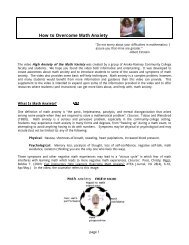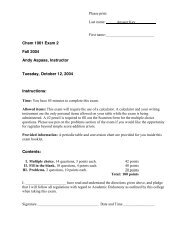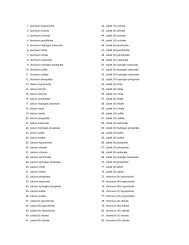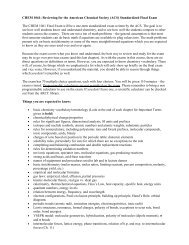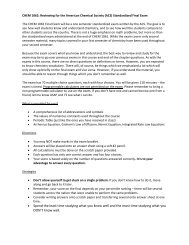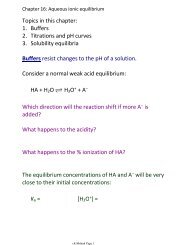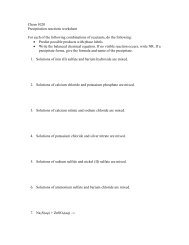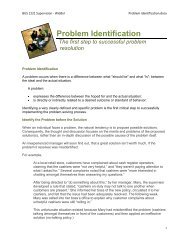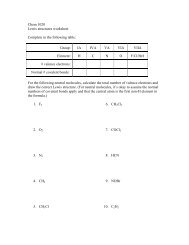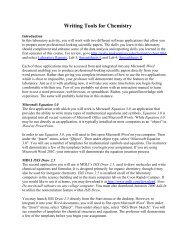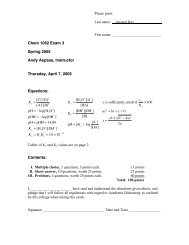Sample Lab Report - Anoka-Ramsey Community College
Sample Lab Report - Anoka-Ramsey Community College
Sample Lab Report - Anoka-Ramsey Community College
- No tags were found...
Create successful ePaper yourself
Turn your PDF publications into a flip-book with our unique Google optimized e-Paper software.
Using Absorbance to Determine the Concentration of CuSO 4John DoeSue SmithSubmitted: 5/8/2013AbstractThis experiment was carried out to explore the relationship between the absorbance and concentrationof colored solutions. After determining the λ max was 635 nm for CuSO 4 , the absorbance of six solutionsof CuSO 4 , ranging from 0.00 to 0.50 M, was found using a colorimeter. Graphical analysis revealed thatthe relationship between absorbance and concentration was directly proportional with a molarabsorptivity of 2.81 M -1 cm -1 . The data obtained reinforced the connection between the color of asolution and the wavelengths of light which the solution absorbs and reflects. In addition, knowledge ofthe linear relationship between absorbance and concentration allowed for the determination thatunknown solution #285 was 0.726 M CuSO 4 .IntroductionThe world is full of a multitude of colors that are used for both practical and aesthetic purposes. Thecolors that are seen when looking at different objects are due to the ability of the compounds in thoseobjects to absorb specific wavelengths of light. In other words, the colors that are seen are the onesthat are not absorbed. The wavelengths of light that are absorbed are determined by the electrons in acompound. 1 As electrons move around, they can absorb energy and become excited. The energy, andthus the wavelength of light, the electrons absorb is determined by the type of atoms found in thecompound and how those atoms are bound together. Different environments for electrons will alsodetermine how much of a particular wavelength of light can be absorbed, a parameter which is reflectedin the molar absorptivity of the compound. 2Because the color of a species is due to its ability to absorb light, the color should become darker ormore intense as the concentration increases. The increase in concentration leads to more electrons inthe sample which can then absorb more light at a particular wavelength. Thus, there should be arelationship between the concentration of the compound being studied and its absorbance. Thisrelationship is best determined using a wavelength of light in a region of the visible spectrum where themaximum absorbance is observed. This wavelength is known as λ max and is most sensitive to thechanges in concentration.The purpose of this experiment was to study the absorbance of CuSO 4 . Because copper compoundstend to be blue in color, 3 it was hypothesized that the CuSO 4 would have a λ max with a longer wavelengthcorresponding to a color more in the range of orange or red. Once the best wavelength for studyingCuSO 4 was determined, it could then be used to examine the relationship between the absorbance andconcentration of the compound and use that relationship to calculate desired information for unknownsolutions.Experimental ProcedureSix samples were prepared for analysis by diluting a 0.50 M CuSO 4 stock solution. 4 The amounts of theCuSO 4 stock solution and water used in each sample is indicated in Table 1. A Vernier colorimeter wasattached to the <strong>Lab</strong>Pro interface and the LoggerPro software was adjusted to display absorbances. The
Absorbanceabsorbance of the 0.50 M CuSO 4 was determined using a 1 cm cuvette at each of the four wavelengthson the colorimeter (Appendix 1), and 635 nm was chosen as the λ max . The absorbance of each of thestandard solutions was then determined at 635 nm. Unknown solution #285 was obtained and itsabsorbance was measured. Because the absorbance was higher than that of the 0.50 M standard, theunknown was diluted in a 1:1 ratio with DI water, and the absorbance was measured again.ResultsThe absorbances of the CuSO 4 standard solutions were directly proportional to their concentrations(Table 1, Figure 1). The slope obtained for the graph is equivalent to the molar absorptivity since thecuvette had a pathlength of 1 cm. Thus, the molar absorptivity of CuSO 4 at 635 nm is 2.81 M -1 cm -1 . Thismolar absorptivity could be used to determine the concentration of unknown #285. The absorbance ofthe undiluted solution was much higher (1.683) than the 0.50 M standard solution. After diluting 2.00mL of the unknown with 2.00 mL of DI water, the absorbance obtained was 1.021. This corresponded toa concentration of 0.363 M CuSO 4 for the diluted solution. The undiluted unknown #285 wouldtherefore be twice that of the diluted, or 0.726 M CuSO 4 .Table 1. Preparation of standard CuSO 4 solutions and their absorbances at 635 nm.Concentration ofStandard CuSO 4Solution (M)Volume of 0.50 MCuSO 4 StockSolution (mL)Volume of DIWater (mL)Absorbanceat 635 nm0.00 0.00 5.00 0.0000.10 1.00 4.00 0.4060.20 2.00 3.00 0.6380.30 3.00 2.00 0.8540.40 4.00 1.00 1.2020.50 5.00 0.00 1.2761.61.41.2Abs = 2.81 ConcR² = 0.9610.80.60.40.200 0.1 0.2 0.3 0.4 0.5 0.6Concentration (M)Figure 1. Determination of molar absorptivity of CuSO 4 . The blue diamonds are from the standardsolutions. The red square is the diluted sample of unknown #285.
DiscussionThe purpose of this experiment was two-fold: to determine the λ max and molar absorptivity of CuSO 4and to use that information to establish the concentration of an unknown CuSO 4 solution. It wasassumed that the CuSO 4 solution, being blue in color, would reflect lower wavelengths of light whichcorrespond to the blue color and absorb better at higher wavelengths of light. This was supported bythe results of the experiment. Of the four wavelengths available on the colorimeter (430 nm, 470 nm,565 nm, and 635 nm), the greatest absorbance was observed at 635 nm (Appendix 1). Thus, the λ max forthe solution was determined to be 635 nm which corresponds to a red color. 5The absorbance of each of the standard CuSO 4 solutions was measured at 635 nm to determine themolar absorptivity of CuSO 4 at this wavelength. As shown in Figure 1, absorbance and concentrationwere directly proportional to each other. Based on Beer's Law (A = εcl), 4 the slope of the line should beequal to the molar absorptivity multiplied by the cell pathlength. Since the cell pathlength for thisexperiment was 1 cm, the value of the molar absorptivity was equal to the slope of the line. Thus, it wasdetermined that the molar absorptivity of the CuSO 4 at 635 nm was 2.81 M -1 cm -1 .One factor that is obvious from Figure 1 is that the data was not as precise as desired based on the R-squared value of 0.96 obtained for the trendline analysis. It is assumed that the inconsistencies in thedata were due to errors in the dilution of the stock solution when making the standard CuSO 4 solutions.Because no dilution was necessary for the 0.00 M and 0.50 M CuSO 4 solution, these two data points canbe understood to be correct. If one imagines a line connecting these two data points, all of the otherpoints would be above the line, meaning that their absorbances are greater than predicted for theconcentrations. This would suggest that too much of the 0.50 M CuSO 4 stock solution was used in thepreparation of the standards or too little DI water. Upon reflection, it was determined that theexperimenter in charge of measuring the CuSO 4 solution read the pipettes incorrectly and that this wasthe source of the error. In the future, better communication between lab partners and double-checkingmeasuring techniques would help to prevent these errors and improve the accuracy of the data.The molar absorptivity determined from the standard CuSO 4 solutions can be used to calculate theabsorbance of a known CuSO 4 solution or the concentration of an unknown CuSO 4 solution. Forexample, while a 0.25 M CuSO 4 solution was not used as a standard, its absorbance can be predicted tobe 0.703 in a 1 cm cuvette:A = εclA = (2.81 M -1 cm -1 )(0.25 M)(1.0 cm)A = 0.703Likewise, for unknown #285, the concentration could be determined. Because the concentration of theunknown was greater than the 0.50 M CuSO 4 standard, the unknown was diluted with DI water in a 1:1ratio. This resulted in a diluted solution with an absorbance of 1.021. Using Beer's Law, theconcentration could then be calculated:c = A/εl1.021c 1 1(2.81M cm )(1.0cm)c = 0.363 M
Because of the 1:1 dilution of the unknown with water, the concentration of the undiluted solution #285would be twice that of the diluted solution, or 0.726 M CuSO 4 . Although this does fit well with thestandard solutions, it has already been noted that the trendline analysis was not very accurate.Therefore, it is likely that true value of the unknown concentration is slightly greater than 0.726 M.ConclusionSolutions of CuSO 4 absorb more light at higher wavelengths than at lower wavelengths, correspondingwell with the blue color of the solution. The molar absorptivity of CuSO 4 at 635 nm is 2.81 M -1 cm -1 .Knowledge of this value allows for the determination that unknown #285 is at least 0.726 M CuSO 4 .References(1) Cornell University. http://www.ccmr.cornell.edu/education/ask/?quid=1297 (accessed May 7,2013).(2) Biology Online. http://www.biology-online.org/dictionary/Molar_absorptivity (accessed May 7,2013).(3) Western Oregon University. Transition Metal Complexes and Color.http://www.wou.edu/las/physci/ch462/tmcolors.htm (accessed May 7, 2013).(4) <strong>Anoka</strong>-<strong>Ramsey</strong> <strong>Community</strong> <strong>College</strong>. Determining the Concentration of a Solution: Beer's Law.http://webs.anokaramsey.edu/chemistry/Chem101/<strong>Lab</strong>s/BeersLaw/BeersLaw-S13. pdf (accessed May1, 2013).(5) Visible Spectrum. http://www.giangrandi.ch/optics/spectrum/spectrum.shtml (accessed May 7,2013).Appendix 1. Determination of λ max for 0.50 M CuSO 4 .Wavelength (nm) Absorbance430 0.000470 0.001565 0.796635 1.276Appendix 2To prepare 700.0 mL of 0.30 M CuSO 4 , you would need to use 33.5 g of CuSO 4 and add DI water until youobtain 700.0 mL of solution.0.30molCuSO4159.62 g CuSO40.7000 L 33.5g CuSO41L 1molCuSO4



